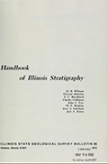Historical:Franconia Formation: Difference between revisions
m (Protected "Historical:Franconia Formation" ([Edit=Allow only administrators] (indefinite) [Move=Allow only administrators] (indefinite))) |
(No difference)
|
Latest revision as of 18:09, 28 November 2016
Lithostratigraphy: Knox Dolomite Megagroup >>Franconia Formation
Chronostratigraphy: Paleozoic Erathem >>Cambrian System >>Croixan Series >>Franconian Stage
Allostratigraphy: Sauk Sequence
Author
T. C. Buschbach
Name Origin
The Franconia Formation is named for Franconia, Chisago County, Minnesota.
Type Section
The type section for the Franconia Formation is in Franconia, Chisago County, Minnesota, and consists of 100 feet of sandstone and shale.
Other Names
In Illinois, these strata were originally differentiated as Mazomanie by Thwaites (1927) and first assigned to the Franconia by Workman (1935). The Franconia Formation is also recognized in Wisconsin, Iowa, Michigan, Indiana, and Kentucky, and it is equivalent to the Elvins Group in Missouri.
Extent and Thickness
The Franconia Formation underlies all of Illinois but is exposed in only one locality, half a mile east of Oregon, Ogle County, where the upper 30 feet, overlain by the Potosi Dolomite, is poorly exposed. This is the oldest formation exposed in Illinois, although it and older Cambrian strata may underlie the glacial drift along the south side of the Sandwich Fault Zone in Ogle, Lee, or De Kalb Counties. The Franconia Formation thickens southward from about 50 feet near the northern boundary of Illinois to probably 500-700 feet in the southern part of the state (fig. Є-11).
Description
The Franconia Formation (Berkey, 1897, p. 373) consists of glauconitic, argillaceous sandstone and dolomite underlying the relatively pure Potosi Dolomite. In extreme northern Illinois, the Franconia consists largely of gray to pink, glauconitic, silty, argillaceous, fine-grained, dolomitic sandstone that contains various amounts of red and green shale. Raasch reported several species of trilobites, oboloid brachiopods, and worm casts in the exposure at Oregon (Willman and Templeton, 1951). Southward from that area the lowermost part of the Franconia becomes increasingly shaly (Davis Member), and the uppermost part grades to silty and sandy dolomite (Derby-Doerun Member). In north-central Illinois these two units are separated by a wedge of fine-grained, glauconitic, dolomitic sandstone similar to the strata that compose the entire Franconia of extreme northern Illinois. In the central and southern parts of the state, the glauconitic sandstone is absent, and the silty, shaly sandstone of the Davis is directly overlain by the relatively pure dolomite of the Derby-Doerun. Because of its diminishing amounts of sand, shale, and glauconite, the upper part of the Franconia is difficult to differentiate from the overlying Potosi Dolomite, and the base of the Knox Dolomite Megagroup steps down to include the Derby-Doerun Member. In Illinois the Franconia is conformable with the overlying and underlying formations.
References
BERKEY, C. P., 1897, Geology of the St. Croix Dalles: American Geologist, v. 20, p. 345-383.
THWAITES, F. T., 1927, Stratigraphy and geologic structure of northern Illinois: Illinois State Geological Survey Report of Investigations 13, 49 p.
WILLMAN, H. B., and J. S. TEMPLETON, 1951, Cambrian and Lower Ordovician exposures in northern Illinois: Illinois Academy of Science Transactions, v. 44, p. 109-125; Illinois State Geological Survey Circular 179, 1952.
WORKMAN, L. E., 1935, Mississippi Valley geologic cross section: Kansas Geological Society Guidebook, 9th Annual Field Conference, p. 362-367, 370, fig. 232.
ISGS Codes
| Stratigraphic Code | Geo Unit Designation |
|---|---|

